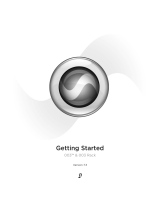
Getting Started with MIX12
3 In the Appearance Control Panel do the fol-
lowing:
• Click the Fonts tab and set the Large System
Font to Chicago. In addition, deselect
“Smooth all fonts on screen.”
• Click the Sound tab and select None from the
Sound Track pop-up menu.
4 In the Extensions Manager Control Panel do
the following:
• Choose Mac OS 9.1 Base (or Mac OS 9.2 Base,
Mac OS 9.2.1, or Mac OS 9.2.2) from the Se-
lected Set pop-up menu. This is done to avoid
any potential extensions conflicts.
• Click Restart to restart your computer.
To install Pro Tools software:
1 Locate the Pro Tools Installer CD for Macin-
tosh and place it in your CD-ROM drive. Locate
and double-click the file named “Install
Pro Tools.”
2 Select the hard drive on which to install
Pro Tools from the Install Location pop-up
menu. For maximum reliability, install
Pro Tools on your startup drive.
3 Select the appropriate installer for your
Digidesign hardware: Pro Tools|24 MIX, or
Pro Tools|24.
4 Several optional items are listed directly below
the main installation choices. To install any of
these items, select them from the list:
Digidesign Control Panel Add this item if you
want to use your Digidesign hardware with
Sound Manager-compatible applications. For
more information, see Appendix D, “Digidesign
Control Panel (Macintosh Only).”
DigiTranslator Enables the exchange of audio
and video files, and sequences between
OMFI-compatible applications and Pro Tools.
Procrastinator Add this item if you have a
Pro Tools|24 MIX system and one or more DSP
Farm cards and you want to use the Procrastina-
tor
™
extended delay plug-in. This is useful if you
plan to open old sessions that use the Procrasti-
nator Plug-In. (Do not select this item if you
have a Pro Tools|24 system—Procrastinator is
automatically installed for you.)
Machine Control Users Guide Install this docu-
ment if you also use Digidesign’s MachineCon-
trol option for Pro Tools.
5 After selecting from the above options, click
Install.
6 Select an initial set of Pro Tools Preferences.
These Preference “sets” have been pre-config-
ured to include some of the more popular set-
tings for post production, audio, and audio with
MIDI. After selecting a setting, click Continue.
Preference settings can be customized at any
time in Pro Tools. See the Pro Tools Reference
Guide for more information about Preferences.
For more information on DigiTranslator,
see the DigiTranslator Guide.
Selecting a Pro Tools Preference





















